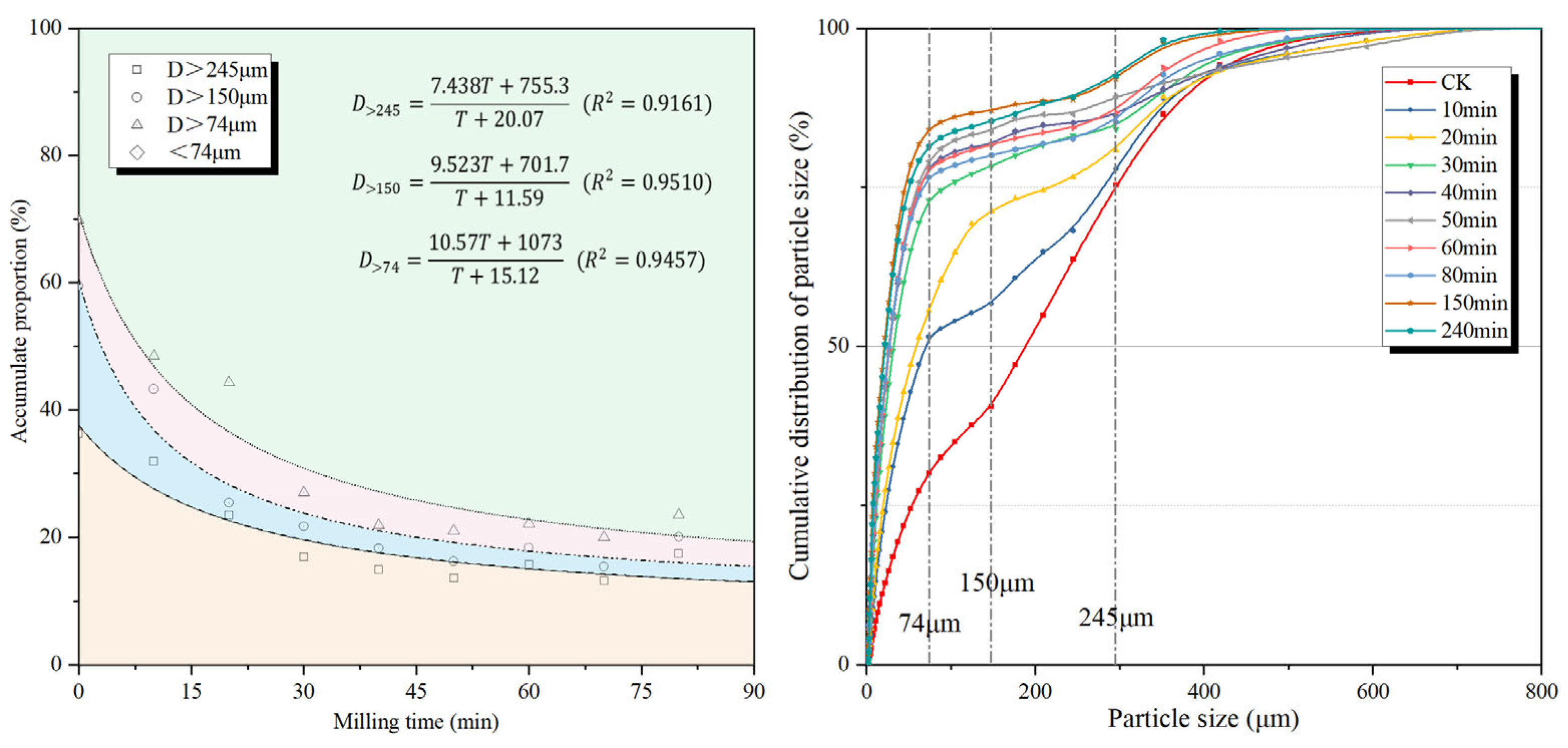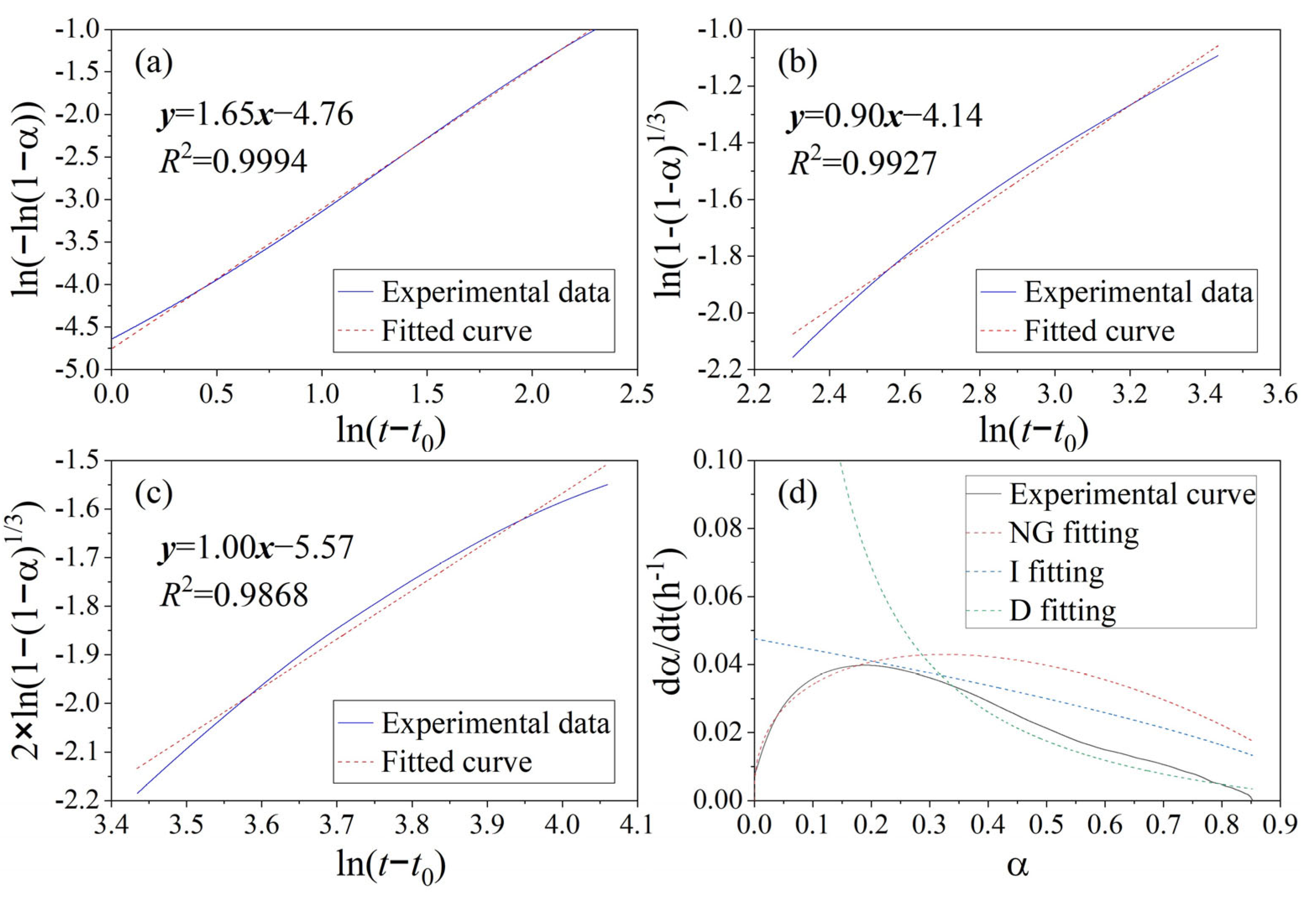3.1. Properties of Raw Materials
The chemical composition and trace elements of the raw materials are shown in
Table 1. The main chemical components of MSWIFA are CaO, SiO
2, Al
2O
3, and a large amount of soluble potassium salts, sodium salts, chlorides, sulfates, etc. Compared with Portland cement and slag, MSWIFA has the characteristics of high salt content, which restricts its use as an auxiliary cementitious material. Compared to ground granulated blast furnace slag and cement, fly ash contains higher concentrations of heavy metals such as Cr, Cu, Pb, and Zn, reaching 2793.12, 689.65, 1397.29, and 6917.43 mg/kg, respectively. These values are one to two orders of magnitude greater than those found in slag and cement.
The XRD pattern is shown in
Figure 1b. The main mineral phases of cement are tricalcium silicate (C
3S), dicalcium silicate (C
2S), tricalcium aluminate (C
3A), tetracalcium aluminoferrite (C
4AF), CaCO
3, and anhydrite (CaSO
4). The main mineral phases of MSWIFA are anhydrite, sylvite, halite, quartz, CaCO
3, and gehlenite. The solid phase in blast furnace slag powder is mainly amorphous, and its diffraction pattern shows a relatively broad steamed bun peak.
MSWIFA contains a certain quantity of aluminosilicates, as well as calcium chloride and calcium sulfate, and it can be used as a slag-based cementitious material. The main physical properties of the raw materials are shown in
Table 2. Compared with slag and cement, the specific gravity and Blaine specific surface area of MSWIFA are relatively low, possibly due to agglomeration. It needs to be milled to reduce the particle size and enhance its activity, promoting the hydration reaction.
3.3. Response Surface Optimization of MSWIFA Modification Process
The surface of MSWIFA particles was modified with triethanolamine and sodium hexametaphosphate (TEA-STPP) as grinding aids. The range of factors is shown in
Table 3. According to the ratio of the test design, specific experiments were carried out to obtain the experimental results. Multiple regression analysis of the experimental results found that the second-order model can simulate the experimental results well, and the specific expression is as follows:
Table S2 shows the variance analysis of the model.
Table S3 shows the estimated coefficients for coded factors. The F value of the model is 281.1, indicating that the established second-order model is significant. There is less than a 0.001% chance of data being larger than the F value, which is caused by the signal-to-noise ratio. The value of “Prob. > F” less than 0.0001 indicates that the model parameters are significant. The F value indicates the significance of the model equation [
39]. The regression response value of “Prob. > F” less than 0.05 means that the model parameters are significant [
40], while the opposite is true when it is greater than 0.1. In this experiment [
41], A, B, C, AB, AC, A
2, B
2, and C
2 are significant model parameter terms.
Table 4 shows the statistical results of response surface fitting. R
2 (0.9958) indicates that the model explains over 99% of the variability in the data, suggesting an excellent fit. The low standard deviation (0.5331) confirms that the actual data points are closely clustered around the model’s predicted values, reflecting high precision. Meanwhile, the Predicted R
2 (0.9441), while slightly lower than the adjusted R
2, remains high and shows that the model maintains strong predictive power for new observations, with only a minor degree of overfitting. Overall, these metrics demonstrate a highly accurate and reliable model.
Figure 5 shows a three-dimensional response surface plot of the experimental results obtained by the analysis software, in which the 74 μm sieve residue is the
Z-axis response value, and the X and Y axes are two of the experimental influencing factors. When two of the influencing factors are the X and Y axis variables, the other influencing factor remains unchanged and is at the 0 level. The three-dimensional response surface and the corresponding contour plot can be used to easily and simply check the response of the influencing experimental variables [
42]. The grinding aid TEA-STPP dosage A, ball-to-material ratio B, and ball-milling time C have obvious interactive effects on the improvement in the 74 μm sieve residue ratio. Through analysis and response surface optimization, the optimal experimental parameters can be obtained: the grinding aid TEA-STPP dosage is 0.07%; the ball-to-material ratio is 0.33; the ball-milling time is 44 min; and the 74 μm sieve residue is 0.63%.
The grinding aids play a role in reducing the surface energy in the early stage of grinding, not only preventing crack closure but also promoting crack expansion and accelerating the generation of fractures. In the middle and late stages of grinding, the triethanolamine (TEA) mainly plays a dispersing role, delaying or reducing the agglomeration of fine materials [
43]. The sodium hexametaphosphate (STPP) can selectively adsorb and electrically neutralize on the surface of the material, eliminating the electrostatic effect [
44], reducing the ability and opportunity of fine particle aggregation, thereby reducing the phenomenon of ball coating and lining plate pasting in the mill, eliminating or greatly reducing the liner formed by adhering fine powder on the steel ball and the inner wall of the mill, improving the dispersion of fine powder materials, improving the utilization rate of mechanical energy, and thus improving the grinding efficiency of the mill. The points in the graph cluster closely around the straight reference line (
Figure 5c), indicating that the residuals approximately follow a normal distribution and further supporting the validity of the model.
3.4. Hydration Reaction Kinetics of the MSWIFA-BFS-OPC Ternary System
From the hydration heat release curves of OPC, the MSWIFA+OPC system, and the MSWIFA+BFS+OPC system at different periods in
Figure 6, it can be seen that the hydration heat release process of the cementitious system doped with MSWIFA is similar to that of the cement-based material cementitious system, and can also be divided into five stages such as the early hydration stage, hydration induction stage, hydration acceleration stage, and hydration deceleration stage [
45], but there are certain differences in the reaction process.
The total amount of 72 h hydration heat from high to low is pure OPC > MSWIFA+OPC > MSWIFA+BFS+OPC; the time corresponding to the peak of the initial hydration reaction heat flow from fast to slow is MSWIFA+BFS+OPC > MSWIFA+OPC > OPC; the initial hydration reaction heat flow value from high to low is MSWIFA+BFS+OPC > OPC > MSWIFA+OPC; the time corresponding to the peak of the second reaction heat flow from fast to slow is MSWIFA+BFS+OPC > MSWIFA+OPC > OPC; and the peak of the second reaction heat flow from high to low is OPC > MSWIFA+OPC > MSWIFA+BFS+OPC.
Incorporating MSWIFA can reduce the total hydration heat of the cementitious system, and the reduction amplitude is equal to its dosage (15%), which is consistent with the reduction in the 7 d strength of the cement mortar mixed with MSWIFA alone mentioned above.
Incorporating MSWIFA can accelerate the participation of OPC in early hydration and increase the amount of its participation in the reaction. That is, the time corresponding to the peak of the C3A reaction heat flow is advanced from 276.8 to 224.9 s, and the peak of the heat flow is only reduced by 5% (less than the reduction in its dosage by 15%); the time corresponding to the peak of the C3S and C2S reaction heat flow is advanced from 9.45 to 8.91 h, and the reduction in the peak of the heat flow is 9% (less than the dosage of 15%).
Compound incorporation of MSWIFA and BFS reduces the total hydration heat of the cementitious system, and its reduction amplitude (28%) is slightly higher than its dosage (25%).
This compound incorporation also accelerates the participation of OPC in early hydration and increases the amount of its participation in the reaction [
46]. Among them, the time corresponding to the peak of the C
3A reaction heat flow is shortened by half compared to the benchmark cement, that is, from 276.8 to 138.4 s, and the peak of the heat flow increases from 1.402 to 2.690 mW, which significantly promotes the hydration of C
3A in OPC and the generation of Federal’s salt and SO
4-AFm [
47]; the time corresponding to the peak of the C
3S and C
2S reaction heat flow is advanced from 9.45 to 7.66 h, and the reduction in the peak of the heat flow is 23% (less than the dosage of 25%).
The K-D models for the hydration heat curve of OPC, the MSWIFA+OPC system, and the MSWIFA+BFS+OPC system are shown in
Figure 7,
Figure 8 and
Figure 9, respectively. Knudsen equation parameters are presented in
Table 5. Combining the results of hydration heat and microcalorimeter experiments, it is found that the incorporation of MSWIFA has an accelerating effect on the early hydration of OPC: the inert particles of extremely fine MSWIFA act as crystal nuclei and are uniformly dispersed in the cementitious system [
48], promoting the early hydration of aluminum and silicon phase minerals in OPC through the diffusion-activating nucleation sites [
49], manifested as the increase in the time the hydration heat peak appears on the hydration heat release curve and the increase in the initial heat flow value; shortening the induction period of cement hydration, causing it to enter the acceleration period in advance; and promoting the early hydration of cement. However, due to the low activity of MSWIFA, the long-term hydration heat of the composite cementitious system is always less than that of the OPC system. When MSWIFA and BFS are compounded, due to the larger specific surface area and higher activity of the BFS, the early hydration acceleration effect of OPC is more significant, but the later hydration rate is reduced; when 5% BFS and 20% MSWIFA are compounded, the initial heat flow peak in the early hydration stage of the cementitious system is equivalent to twice that of the benchmark cement, and the heat flow peak in the acceleration stage is reduced by 23% compared to the benchmark cement (the reduction amplitude is less than its dosage of 25%).
The kinetic parameters determined by means of the K-D model are presented in
Table 6. n is the reaction order, also known as the geometric crystal growth exponent, which reflects the capability of crystal nucleation and growth [
50]. The n value of MSWIFA+OPC is slightly higher than that of OPC, suggesting a more intensive geometric process of crystal nucleation and growth in the hydration products of MSWIFA+OPC. Furthermore, the K
NG, K
I, and K
D values of MSWIFA+BFS+OPC are all higher than those of MSWIFA+OPC and OPC. This indicates that the reaction rates of MSWIFA+BFS+OPC in the nucleation and growth (NG), induction (I), and diffusion (D) stages are higher than those of the other two mixtures. The enhanced reactivity is attributed to the fact that GGBFS and MSWIFA, under the alkaline conditions provided by cement, can form more highly reactive chlorine- and sulfur-containing hydration products [
17]. Relevant studies indicate that the high alkalinity in MSWIFA promotes the formation of more C-(A)-S-H gels [
51].
Figure 10 also indicates the presence of numerous hexagonal platy Friedel’s salt-like structures in the MSWIFA+BFS+OPC sample.















